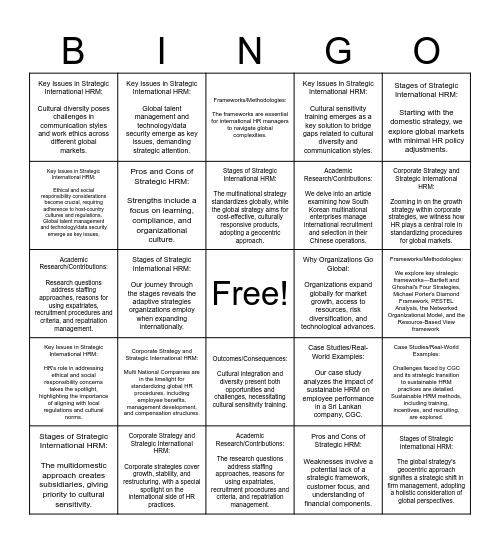

This bingo card has a free space and 24 words: Corporate Strategy and Strategic International HRM: Multi National Companies are in the limelight for standardizing global HR procedures, including employee benefits, management development, and compensation structures., Corporate Strategy and Strategic International HRM: Corporate strategies cover growth, stability, and restructuring, with a special spotlight on the international side of HR practices., Stages of Strategic International HRM: The multinational strategy standardizes globally, while the global strategy aims for cost-effective, culturally responsive products, adopting a geocentric approach., Stages of Strategic International HRM: The multidomestic approach creates subsidiaries, giving priority to cultural sensitivity., Stages of Strategic International HRM: Starting with the domestic strategy, we explore global markets with minimal HR policy adjustments., Key Issues in Strategic International HRM: Cultural diversity poses challenges in communication styles and work ethics across different global markets., Key Issues in Strategic International HRM: Ethical and social responsibility considerations become crucial, requiring adherence to host-country cultures and regulations. Global talent management and technology/data security emerge as key issues,, Key Issues in Strategic International HRM: Global talent management and technology/data security emerge as key issues, demanding strategic attention., Why Organizations Go Global: Organizations expand globally for market growth, access to resources, risk diversification, and technological advances., Outcomes/Consequences: Cultural integration and diversity present both opportunities and challenges, necessitating cultural sensitivity training., Academic Research/Contributions: We delve into an article examining how South Korean multinational enterprises manage international recruitment and selection in their Chinese operations., Academic Research/Contributions: Research questions address staffing approaches, reasons for using expatriates, recruitment procedures and criteria, and repatriation management., Case Studies/Real-World Examples: Our case study analyzes the impact of sustainable HRM on employee performance in a Sri Lankan company, CGC., Case Studies/Real-World Examples: Challenges faced by CGC and its strategic transition to sustainable HRM practices are detailed. Sustainable HRM methods, including training, incentives, and recruiting, are explored., Pros and Cons of Strategic HRM: Strengths include a focus on learning, compliance, and organizational culture., Pros and Cons of Strategic HRM: Weaknesses involve a potential lack of a strategic framework, customer focus, and understanding of financial components., Frameworks/Methodologies: We explore key strategic frameworks—Bartlett and Ghoshal's Four Strategies, Michael Porter's Diamond Framework, PESTEL Analysis, the Networked Organizational Model, and the Resource-Based View framework., Frameworks/Methodologies: The frameworks are essential for international HR managers to navigate global complexities., Corporate Strategy and Strategic International HRM: Zooming in on the growth strategy within corporate strategies, we witness how HR plays a central role in standardizing procedures for global markets., Stages of Strategic International HRM: Our journey through the stages reveals the adaptive strategies organizations employ when expanding internationally., Stages of Strategic International HRM: The global strategy's geocentric approach signifies a strategic shift in firm management, adopting a holistic consideration of global perspectives., Key Issues in Strategic International HRM: HR's role in addressing ethical and social responsibility concerns takes the spotlight, highlighting the importance of aligning with local regulations and cultural norms., Key Issues in Strategic International HRM: Cultural sensitivity training emerges as a key solution to bridge gaps related to cultural diversity and communication styles. and Academic Research/Contributions: The research questions address staffing approaches, reasons for using expatriates, recruitment procedures and criteria, and repatriation management..
Mastering Strategic HRM: Key Concepts & Challenges | Change Management | United People Bingo | Quality & Safety | CUIC BINGO
Share this URL with your players:
For more control of your online game, create a clone of this card first.
Learn how to conduct a bingo game.
With players vying for a you'll have to call about __ items before someone wins. There's a __% chance that a lucky player would win after calling __ items.
Tip: If you want your game to last longer (on average), add more unique words/images to it.